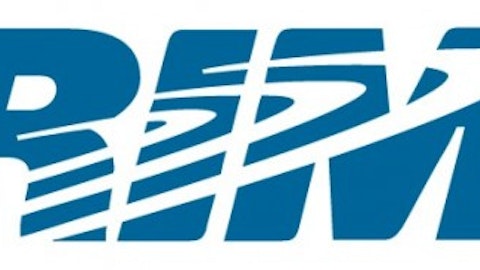Graphics chip specialist NVIDIA Corporation (NASDAQ:NVDA) displayed robust performance in its fiscal fourth-quarter earnings, where profits exceeded Street expectations. But the company’s future is still bothering some of the analysts who track it.
NVIDIA gave a lower-than-estimated revenue forecast for the current quarter. The chief culprit, according to the company, continues to be the worldwide fall in PC sales, as people increasingly shift to smartphones and tablets. As expected, the Street was quick to react; NVIDIA stock prices took a hit.

NIVDIA’s primarily known for its graphics chips, targeted at gaming enthusiasts as well as designers. And while it’s true that this segment of its consumers is no longer dependant on their personal computers, the company’s chips are equally acceptable in the realm of phones, tablets, and independent gaming devices. The fact that Google Inc (NASDAQ:GOOG)’s Nexus 7 and Microsoft Corporation (NASDAQ:MSFT)’s Surface tablets use NIVIDIA chips is proof enough of its ability to effect a quick transition from the PC side. This is also where its reputation as a graphics chip specialist would be hard to beat, especially by bigger rivals such as QUALCOMM, Inc. (NASDAQ:QCOM).
It’s true that Qualcomm’s chips are synonymous with two things – integration and support for the next-generation Long-Term Evolution (LTE) wireless network standard. Qualcomm has already mastered the ability to integrate the processor (the brain of a smartphone) with the modem and its current 860 Snapdragon line of processors combine LTE connectivity which is the major reason why the company has had a near-monopoly in LTE-capable chip sales, with a whopping 86% market share in 2012.
However, I feel that can be taken care of by NVIDIA’s twin weapons – the Tegra 4 and the ‘Icera’ factor. The company’s Tegra 4 line of chipsets combines the company’s famous graphics processor abilities with that of a modem.
And then there’s the 2011 acquisition of wireless startup Icera by NVIDIA in 2011. Icera’s baseband chips can actually be tuned into a number of frequencies, and NVIDIA’s latest Tegra avatar, the Tegra 4i, successfully combines the Icera chip with the Tegra application processor. Now that’s a real challenge to Qualcomm, since it effectively means that the Tegra 4i chips can support LTE as well as other frequencies such as HSPA, with the latter used by carriers such as AT&T and T-mobile.
If you look at it that way, the Icera factor may be the company’s ticket to gatecrash into the upcoming 4G LTE party. And don’t forget that Tegra group revenue went up by 90% on a year-over-year basis. Already, Tegra 4 sales are better placed than Tegra 3 sales at about this time. The middle of this year should see the emergence of more devices powered by Tegra 4 — and that’s when the story should get really interesting.
At the same time, NVIDIA needs to be careful not to get into the same kind of problems that Qualcomm faced with manufacturing partnerTaiwan Semiconductor Mfg. Co. Ltd. (ADR) (NYSE:TSM) last year, for the latter’s 28-nanometer production line. After all, Tegra 4 follows the same 28-nanometer production process. Qualcomm is a strong and sometimes overwhelming contender, butas I already said earlier, its Snapdragon processor line should be going in for a revamp sometime soon.
NVIDIA’s not the only one challenging Qualcomm’s near-monopoly in the LTE realm. PeerBroadcom Corporation (NASDAQ:BRCM)has gotten into the LTE race also, and is planning to launch an LTE-enabled chip of a very high standard, in terms of speed, compatibility, and its range of frequency bands around the world. Through this product, Broadcom, which is already an established name in the realm of chips that combine Wi-Fi and Bluetooth capabilities, is preparing to launch an assault on Qualcomm’s chip dominance in mobile processors. What’s also important is that Broadcom is touting this to be an ‘LTE-advanced’ chip, thus aiming at the cream of the market share.
At the same time, NIVIDIA hasn’t forgotten the loyal audience of gamers who depend on its chips. That brings us to another expected major boost to the company’s stock prices in the shape of Project Shield. The latter is a purely Android standalone gaming device that is powered by NVIDIA’s Tegra processor. Project Shield offers gamers access to both the Google Play Store and its own Tegra Zone. What’s important is the fact that Project Shield offers gamers the power of an open platform like Android. NVIDIA has been quick to recognize the growing importance of free-to-play, multiplayer gaming, and Project Shield can be a big step in this direction.
Tegra 4i, Icera and Project Shield – this company’s gathered fairly good ammunition to make it big in the current year. NVIDIA continues to score in the tablet space and has a great-looking balance sheet with a strong cash position. At this rate and given these fundamentals, this company should have a strong growth path, particularly in the second part of the year. Keep your faith in this stock. Fool on!
The article There’s Still No Reason To Doubt This Company originally appeared on Fool.com and is written by Subhadeep Ghose.
Copyright © 1995 – 2013 The Motley Fool, LLC. All rights reserved. The Motley Fool has a disclosure policy.




